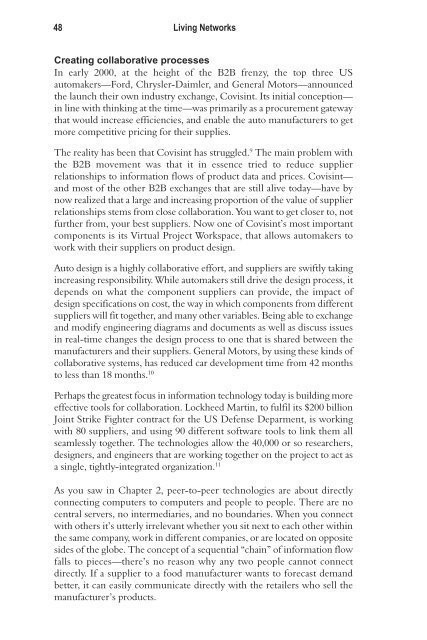Living Networks – Chapter 3: The New Organization - Ross Dawson
Living Networks – Chapter 3: The New Organization - Ross Dawson
Living Networks – Chapter 3: The New Organization - Ross Dawson
You also want an ePaper? Increase the reach of your titles
YUMPU automatically turns print PDFs into web optimized ePapers that Google loves.
48 <strong>Living</strong> <strong>Networks</strong><br />
Creating collaborative processes<br />
In early 2000, at the height of the B2B frenzy, the top three US<br />
automakers—Ford, Chrysler-Daimler, and General Motors—announced<br />
the launch their own industry exchange, Covisint. Its initial conception—<br />
in line with thinking at the time—was primarily as a procurement gateway<br />
that would increase efficiencies, and enable the auto manufacturers to get<br />
more competitive pricing for their supplies.<br />
<strong>The</strong> reality has been that Covisint has struggled. 9 <strong>The</strong> main problem with<br />
the B2B movement was that it in essence tried to reduce supplier<br />
relationships to information flows of product data and prices. Covisint—<br />
and most of the other B2B exchanges that are still alive today—have by<br />
now realized that a large and increasing proportion of the value of supplier<br />
relationships stems from close collaboration. You want to get closer to, not<br />
further from, your best suppliers. Now one of Covisint’s most important<br />
components is its Virtual Project Workspace, that allows automakers to<br />
work with their suppliers on product design.<br />
Auto design is a highly collaborative effort, and suppliers are swiftly taking<br />
increasing responsibility. While automakers still drive the design process, it<br />
depends on what the component suppliers can provide, the impact of<br />
design specifications on cost, the way in which components from different<br />
suppliers will fit together, and many other variables. Being able to exchange<br />
and modify engineering diagrams and documents as well as discuss issues<br />
in real-time changes the design process to one that is shared between the<br />
manufacturers and their suppliers. General Motors, by using these kinds of<br />
collaborative systems, has reduced car development time from 42 months<br />
to less than 18 months. 10<br />
Perhaps the greatest focus in information technology today is building more<br />
effective tools for collaboration. Lockheed Martin, to fulfil its $200 billion<br />
Joint Strike Fighter contract for the US Defense Deparment, is working<br />
with 80 suppliers, and using 90 different software tools to link them all<br />
seamlessly together. <strong>The</strong> technologies allow the 40,000 or so researchers,<br />
designers, and engineers that are working together on the project to act as<br />
a single, tightly-integrated organization. 11<br />
As you saw in <strong>Chapter</strong> 2, peer-to-peer technologies are about directly<br />
connecting computers to computers and people to people. <strong>The</strong>re are no<br />
central servers, no intermediaries, and no boundaries. When you connect<br />
with others it’s utterly irrelevant whether you sit next to each other within<br />
the same company, work in different companies, or are located on opposite<br />
sides of the globe. <strong>The</strong> concept of a sequential “chain” of information flow<br />
falls to pieces—there’s no reason why any two people cannot connect<br />
directly. If a supplier to a food manufacturer wants to forecast demand<br />
better, it can easily communicate directly with the retailers who sell the<br />
manufacturer’s products.







